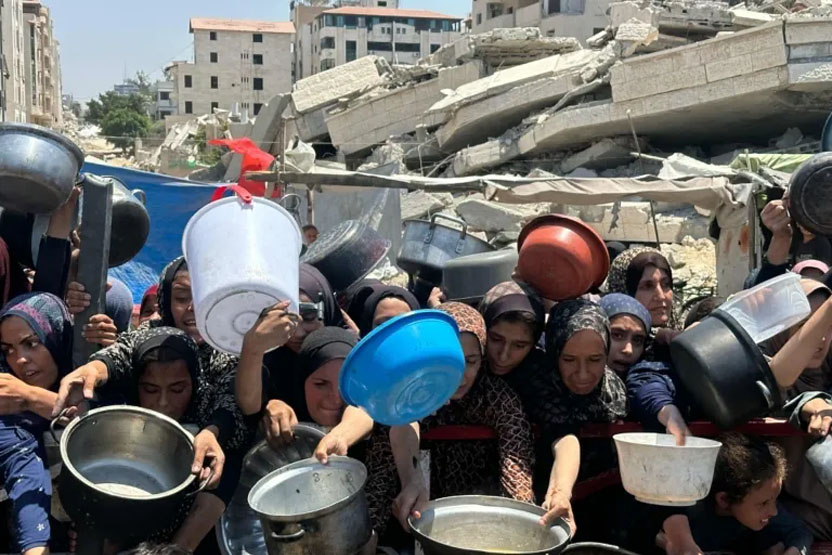This article was published on Al Jazeera and is translated and republished by TiredEarth.com

Mohammad Dar Khalil
translated by TiredEarth
The comprehensive cutoff of food and essential supplies to the Gaza Strip was not divorced from its historical and contextual roots, nor did its first signs appear simply as a reaction to the Al-Aqsa Flood operation on 7 October 2023. Rather, it represents a policy trend adopted by the leaders of the occupation since 2006, after Hamas won the legislative elections.
Documents published in 2008 revealed calculations of the number of calories allotted to Gazans and specified how many trucks would be permitted entry from that time onward.
Statements by Israeli officials were published then referring to what was called “a dietary regimen for the Palestinians, without driving them to death by starvation, but keeping them in a state of continuous deprivation,” words attributed to Dov Weissglas, who was then an adviser in the Prime Minister’s Office.
Numerous historical examples illustrate the use of starvation as a political and military weapon intended to break the will of peoples and cripple their ability to resist — just as happened in the Holodomor in Ukraine (1932–1933), where about four million Ukrainians died, and as occurred during the siege of Leningrad (1941–1945), where roughly one million people perished out of a population of three million.
From the womb of these historical cases we can trace the same motivations in Gaza today: evidence shows that Israel seeks to place Palestinians under a coercive, lethal hunger in the hope of influencing their will and political choices, even forcing them to leave their land. Having failed to break Palestinians’ will militarily, is the occupation now trying to break it by biological means?
An infant suffering severe malnutrition inside the neonatal unit of Nasser Hospital (Al Jazeera)
Biopolitics
Biopolitics, as theorized by the French philosopher Michel Foucault in his lectures at the Collège de France (1975–1976) later published under the title “Society Must Be Defended,” provides a fundamental analytical framework for understanding how political power exercises control over the biological life of populations.
Foucault argued that modern power exerts its dominance through the administration of life itself — by finely controlling basic biological processes such as birth, illness, nutrition, and health. Giorgio Agamben extended this concept in his book “Homo Sacer: Sovereign Power and Bare Life,” where he examined the project of reducing a person to their mere biological existence, stripped of political and human rights.
In this way, the authority decides which people are recognized as members of the political community and which are regarded only in terms of their biological reality. Agamben grounds this distinction using the two Greek terms for life: zoē, meaning “natural, reproductive life” confined to the private sphere, and bios, meaning “a particular form of life,” i.e., political life.
In the Gaza context, this dynamic appears in its most brutal form: hunger is used not only to strip Palestinians of their political will but as a tool to control their bodies and disrupt vital functions as a prelude to manipulating their behavior and decisions. Thus, a basic biological need is transformed into a political weapon aimed at collective will.
Studies show the brain’s need for glucose as a primary energy source, and that a sharp decline in glucose during prolonged food deprivation causes widespread impairment of executive and cognitive functions, along with loss of balance and diminished motivation and drive due to shortages of essential nutrients such as amino acids and vitamins, as neurochemistry research confirms.
Research also indicates that extreme hunger is associated with marked weakness in concentration, memory, and attention, and generates cognitive biases that push people toward short-term decisions favoring immediate acquisition to meet biological survival needs. It drives them into a state akin to immediate obsession, stripping them of the ability to plan long-term or to concentrate on moral or higher-order issues.
The Minnesota starvation experiment
In the Minnesota starvation experiment (1944–1945), whose results were published in the book “The Biology of Human Starvation,” American researcher Ancel Keys and colleagues exposed 36 healthy young volunteers from Europe to partial starvation for six months. The result was a decline in their mental performance; they became consumed by anxieties about food all the time, leaving no room in their minds for other concerns.
Many participants in the experiment — conducted during World War II — fell prey to severe apathy, with a clear decline in the ability to think and an inability to plan. Their hunger became so extreme that decision-making was almost paralyzed.
Moreover, recent neuroscience studies point to hunger’s effect on brain regions responsible for memory and planning: neuroimaging studies have shown that hunger is associated with changes in blood flow and neural activity in the hippocampus, which is responsible for memory formation, and in the prefrontal cortex, which is responsible for future planning.
When the brain is deprived of sufficient nutrition, it loses its full capacity to process temporal frameworks in sequence, including recollecting past victories or imagining the future.
Hunger is killing Gaza’s people (social media platforms)
The Nazi starvation plan
Documents relating to Soviet POW camps in Nazi Germany during World War II reveal the impact of sharply reduced rations on behavior.
Historian Timothy Snyder documented in his book “Bloodlands” that nearly three million Soviet prisoners of war died of starvation in German camps between 1941 and 1945 as a result of a deliberate plan to starve Soviet prisoners.
Soviet POWs were the first victims of the Nazis’ mass-starvation policy in the East. In August 1941 the German army set a daily ration of only 2,200 calories for Soviet prisoners considered fit for work, and although this was — according to Snyder — insufficient to sustain life, in practice prisoners received far less than the official ration.
Many Soviet prisoners received no more than 700 calories per day, and within a few weeks the result of this “subsistence” ration, as the German army termed it, was death by starvation. Snyder noted that POWs were often given a special “Russian” bread made from sugar-beet peel and coarse flour.
When rations fell to these critical levels, there was a noticeable decline in escape attempts and acts of rebellion during the first three months, showing a direct relationship between food deprivation and the capacity to resist.
Severe hunger reprograms human priorities by redirecting the brain toward immediate needs; consequently, one’s resolve may be swamped by forces stronger than one’s will, pushing individuals toward temporary solutions such as migration instead of pursuing options more consistent with fixed national convictions.
The first weeks of famine do not appear sufficient to completely crush will or fully subjugate a person, but accumulation over many months leads — as the Minnesota experiment confirmed — to deterioration affecting body and spirit alike. Those subjected to the brutality of starvation and its horrific conditions find themselves driven toward choices that would have been unthinkable under normal circumstances.
On the other hand, social relationships and bonds often collapse under the severity of conditions that threaten individuals’ existence, such as the spread of famine, and tendencies toward individual survival may grow among citizens due to the lack of food. This scatters the social fabric and thus erodes the collective will necessary to confront any total occupation policies.
Genetic research reveals an even more dangerous long-term dimension. Studies on the “Dutch Hunger Winter,” published in the International Journal of Environmental Research and Public Health and targeting two generations of survivors, found that exposure to famine in utero alters the gene expression of IGF2 — a gene responsible for growth and metabolism.
The Dutch Hunger Winter was a major famine that struck the Netherlands, particularly the Nazi-occupied western part, from November 1944 until the Allies liberated the Netherlands on 5 May 1945. About 22,000 people died and 4.5 million were affected by the direct and indirect consequences of the famine.
Descendants who were indirectly exposed in utero carry “epigenetic scars” that make them more susceptible later in life to chronic psychological and metabolic disorders. In this context, famine may compromise the integrity and balance of will in future generations, leaving subsequent cohorts with chronic exhaustion that could affect their ability to develop a future resistance.
Taken together, these points confirm that creating famine in Gaza is not merely an ad hoc tactic but rather an Israeli strategy based on biological and psychological calculations, aimed at stripping Gazans of the will to endure and to resist.
Multiple coercive methods over the decades have not succeeded in breaking Palestinian will, but starvation may be the harshest weapon they face — one that places all of humanity before a test of how to respond to an unparalleled descent into brutality and moral degradation.
In 2003 and 2004, 18 of the original 36 participants in the Minnesota study were still alive and were interviewed; all of them expressed strong convictions about nonviolence and a desire to make meaningful contributions during wartime.
Despite the ethical problems surrounding the deliberate starvation of healthy people, the interviewed participants agreed they would repeat the experiment even after knowing the suffering they endured — noting that many of them later worked on rebuilding war-torn Europe, served in ministries and diplomatic services, and engaged in other activities related to preventing war.


_1759666699.jpg)
_1759666800.jpg)
Comment
Reply